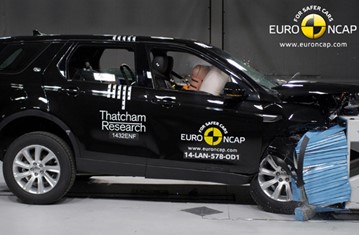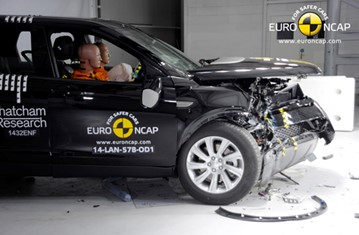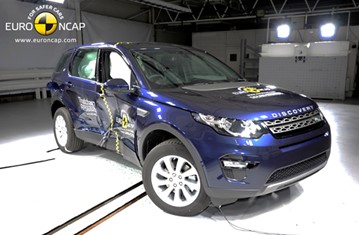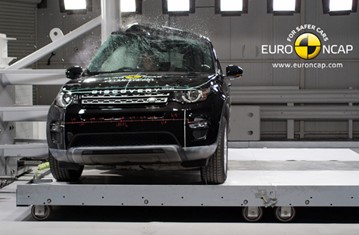Find more information in the General Comments section of the assessment
Find more information in the Rating Validity tab of the assessment
- See More
- See More
- See More
- See More
- Good
- Adequate
- Marginal
- Weak
- Poor
 Passenger
Passenger
 Driver
Driver
 Rear Seat
Rear Seat
 Front Seat
Front Seat
 Car
Car
 Pole
Pole
- Good
- Adequate
- Marginal
- Weak
- Poor


Passenger
outboard
center
outboard
center
Fitted to the vehicle as standard
Not fitted to the test vehicle but available as option
Not Available
-
Infants up to 13 kg
-
Infants and toddlers up to 18 kg
-
Toddlers from 9 to 18 kg
-
Toddlers over 18 kg
Easy
Difficult
Safety critical
Not allowed
| Seat Position | ||||||
|---|---|---|---|---|---|---|
| Front | 2nd row | 3rd row | ||||
| Passenger | Left | center | Right | Left | Right | |
| Maxi Cosi Cabriofix (Belt) | ||||||
| Britax Römer King Plus (Belt) | ||||||
| Britax Römer Duo Plus (ISOFIX) | ||||||
| Britax Römer KidFix (Belt) | ||||||
| Maxi Cosi Cabriofix & EasyFix (Belt) | ||||||
| Maxi Cosi Cabriofix & EasyFix (ISOFIX) | ||||||
| BeSafe iZi Kid X3 ISOfix (ISOFIX) | ||||||
| Maxi Cosi Pearl & Familyfix (ISOFIX) | ||||||
| Britax Römer KidFix (ISOFIX) | ||||||
Easy
Difficult
Safety critical
Not allowed
The Discovery Sport scored maximum points for its protection of the 1½ year dummy in the dynamic crash tests. In the frontal impact, forward movement of the head of the 3 year dummy, sat in a forward-facing restraint, was not excessive, although neck forces were marginally high. In the side impact, both dummies were properly contained within the protective shells of their restraints, minimising the risk of head contact with parts of the vehicle interior. The front passenger airbag can be disabled to allow a rearward-facing child restraint to be used in that seating position. Clear information is provided to the driver regarding the status of the airbag and the system was rewarded. All of the child restraints for which the car is designed could be properly installed and accommodated in the Discovery Sport, including the optional third-row seats.
- Good
- Adequate
- Marginal
- Weak
- Poor

Head Impact 19.2 Pts
Pelvis Impact 0.0 Pts
Leg Impact 5.9 Pts
The bumper offered good or adequate protection to pedestrians' legs but the front edge of the bonnet showed poor protection in all areas tested and scored no points. The Discovery Sport has a pedestrian-protection airbag under the bonnet. When sensors detect that a pedestrian has been struck, an airbag is deployed from underneath a panel at the base of the windscreen to cover part of the screen and the stiff pillars on either side. Land Rover showed that the system operated robustly for a variety of pedestrian statures and over a broad range of speeds. Therefore, the protection offered to a pedestrian's head was assessed with the system deployed. Tests results on the bonnet surface were predominantly good or adequate and almost entirely good on the windscreen and windscreen pillars.
- Good
- Adequate
- Marginal
- Weak
- Poor
| Speed Limitation Function | Manually Set |
| System Name | DSC | |
| Performance | ||
| Applies To | All seats | ||
| Warning | Driver Seat | Front Passenger(s) | Rear Passenger(s) |
| Visual | |||
| Audible | |||
|
|||
| Type | Lane Departure Warning |
| Performance | |
|
LDW Confirmation Test
|
Pass |
| System Name | Autonomous Emergency Braking | |||
| Type | Forward Collision Warning with Auto-Brake | |||
| Operational From | 10 km/h | |||
| Additional Information | Default On | |||
| Performance | | ||||
| Autobrake Function Only | Driver reacts to warning | |||
| Operational Speed | 10-80 km/h | 10-80 km/h | ||
| Approaching a stationary car | See AEB City | Crash avoided up to 50km/h.Crash speed reduced up to 80km/h. | ||
| Approaching a slower moving car | Crash avoided up to 45km/h.Crash speed reduced up to 70km/h. | Crash avoided up to 75km/h.Crash speed reduced up to 80km/h. | ||
| Following a car at short distance | ||||
| Car in front brakes gently | Avoidance | Avoidance | ||
| Car in front brakes harshly | Mitigation | Mitigation | ||
| Following a car at long distance | ||||
| Car in front brakes gently | Mitigation | Avoidance | ||
| Car in front brakes harshly | Mitigation | Mitigation | ||
The Discovery Sport has electronic stability control as standard equipment. A seatbelt reminder is also standard for the front and rear seats as is a lane departure warning system. A driver-set speed limitation device is standard on all but 'S' trim models and met Euro NCAP's requirements for systems of that type. The standard-fit 'Autonomous Emergency Braking' system operates from 10 to 80km/h and showed good performance in Euro NCAP's higher-speed tests.
- Specifications
- Safety Equipment
- Videos
- Rating Validity
Specifications
Tested Model Land Rover Discovery Sport 2.2 diesel SE, RHD
Body Type - 5 door hatchback
Year Of Publication 2014
Kerb Weight 1901kg
VIN From Which Rating Applies - applies to all Discovery Sports of the specification tested
Class Small SUV
Safety Equipment
Note: Other equipment may be available on the vehicle but was not considered in the test year.
Fitted to the vehicle as standard
Fitted to the vehicle as option
Not fitted to the test vehicle but available as option
Not Available
Not Applicable
Videos
Rating Validity








Find more information in the General Comments section of the assessment
 Share
Share











The passenger compartment remained stable in the frontal impact. Good protection was provided to all critical body regions of the passenger dummy. Dummy readings indicated good protection of the knees and femurs of both the driver and passenger. Land Rover demonstrated that a similar level of protection would be provided to occupants of different statures and those sat in different positions, whose knees might strike the dashboard at different locations. In the side impact test, the Discovery Sport scored maximum points with good protection of all body regions. In the more severe side pole test, protection of the chest and abdomen was adequate and that of the other parts of the body was good. The protection provided to front seat occupants against whiplash injury was good; for rear seat occupants, it was marginal. The Discovery Sport is equipped as standard with 'Autonomous Emergency Braking', a system that automatically applies the brakes if a collision is imminent. The system works at the low speeds typical of city driving and helps to reduce injuries, including whiplash.